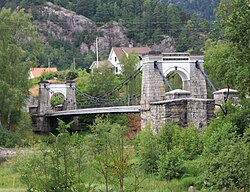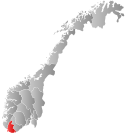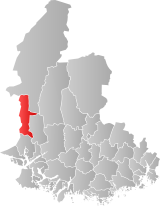Bakke, Norway
Bakke Municipality
Bakke herred | |
|---|---|
 View of a bridge in Bakke | |
 Vest-Agder within Norway | |
 Bakke within Vest-Agder | |
| Coordinates: 58°24′40″N 06°39′27″E / 58.41111°N 6.65750°E | |
| Country | Norway |
| County | Vest-Agder |
| District | Lister |
| Established | 1 Jan 1838 |
| • Created as | Formannskapsdistrikt |
| Disestablished | 1 Jan 1965 |
| • Succeeded by | Flekkefjord and Sirdal municipalities |
| Administrative centre | Sira |
| Area (upon dissolution) | |
• Total | 244 km2 (94 sq mi) |
| Population (1965) | |
• Total | 925 |
| • Density | 3.8/km2 (9.8/sq mi) |
| Time zone | UTC+01:00 (CET) |
| • Summer (DST) | UTC+02:00 (CEST) |
| ISO 3166 code | NO-1045[1] |
Bakke is a former municipality in Vest-Agder county, Norway. The 244-square-kilometre (94 sq mi) municipality[2] existed from 1838 until its dissolution in 1965. It was located in the present-day municipalities of Sirdal and Flekkefjord. It included the whole Sirdalen valley along the Rogaland county border, stretching from the Aust-Agder county border in the north to Sirnes and the lake Lundevatnet in the south. The administrative center was the village of Sira where Bakke Church is located.[3]
History
[edit]The church parish of Bakke (population: 2,378 in 1835[4]) was split into three civil municipalities on 1 January 1838: Vestre Bakke, Østre Bakke, and Gyland. This occurred because the main church parish of Bakke contained land in both the counties of Stavanger and Lister og Mandal and they had to be divided according to the newly passed formannskapsdistrikt law. Due to the very low populations of the three municipalities, this arrangement did not last long. In August 1838, the county border was moved westwards to its current position, and Østre Bakke and Vestre Bakke were merged to form the municipality of Bakke. Then about a year later, in November 1839, Gyland was merged into the municipality of Bakke.[5]
In 1849, the northern district of Sirdal (population: 1,804) was separated from Bakke to become a municipality of its own, leaving 2,597 inhabitants in Bakke. On 31 December 1893, Gyland (population: 1,085) was also separated from Bakke to form a municipality of its own. This split left Bakke with a population of 1,368. On 1 January 1960, the Øksendal area (population: 226) in northern Bakke was merged with Tonstad and Øvre Sirdal municipalities to form a new municipality of Sirdal.[5]
On 1 January 1965, another major municipal merger took place due in part to the work of the Schei Committee. Bakke (population: 925) was merged with the neighboring municipalities of Gyland, Nes, and Hidra and with the town of Flekkefjord to create the new municipality of Flekkefjord.[5]
Name
[edit]The municipality (originally the parish) is named after the old Bakke farm (Old Norse: Bakkar), located on the south side of the present-day village of Sira since the first Bakke Church was built there. The name is the plural form of bakki which means "river bank" or "ridge".[6][7]
Government
[edit]While it existed, this municipality was responsible for primary education (through 10th grade), outpatient health services, senior citizen services, unemployment, social services, zoning, economic development, and municipal roads. During its existence, this municipality was governed by a municipal council of directly elected representatives. The mayor was indirectly elected by a vote of the municipal council.[8]
Municipal council
[edit]The municipal council (Herredsstyre) of Bakke was made up of representatives that were elected to four year terms. The tables below show the historical composition of the council by political party.
| Party name (in Norwegian) | Number of representatives | |
|---|---|---|
| Labour Party (Arbeiderpartiet) | 5 | |
| Christian Democratic Party (Kristelig Folkeparti) | 2 | |
| Centre Party (Senterpartiet) | 2 | |
| Liberal Party (Venstre) | 4 | |
| Local List(s) (Lokale lister) | 2 | |
| Total number of members: | 15 | |
| Party name (in Norwegian) | Number of representatives | |
|---|---|---|
| Labour Party (Arbeiderpartiet) | 4 | |
| Christian Democratic Party (Kristelig Folkeparti) | 2 | |
| Centre Party (Senterpartiet) | 2 | |
| Liberal Party (Venstre) | 4 | |
| Local List(s) (Lokale lister) | 3 | |
| Total number of members: | 15 | |
| Party name (in Norwegian) | Number of representatives | |
|---|---|---|
| Labour Party (Arbeiderpartiet) | 4 | |
| Christian Democratic Party (Kristelig Folkeparti) | 2 | |
| Joint List(s) of Non-Socialist Parties (Borgerlige Felleslister) | 6 | |
| Local List(s) (Lokale lister) | 3 | |
| Total number of members: | 15 | |
| Party name (in Norwegian) | Number of representatives | |
|---|---|---|
| Labour Party (Arbeiderpartiet) | 2 | |
| Christian Democratic Party (Kristelig Folkeparti) | 2 | |
| Local List(s) (Lokale lister) | 8 | |
| Total number of members: | 12 | |
| Party name (in Norwegian) | Number of representatives | |
|---|---|---|
| Labour Party (Arbeiderpartiet) | 2 | |
| Local List(s) (Lokale lister) | 10 | |
| Total number of members: | 12 | |
| Party name (in Norwegian) | Number of representatives | |
|---|---|---|
| Labour Party (Arbeiderpartiet) | 3 | |
| Local List(s) (Lokale lister) | 9 | |
| Total number of members: | 12 | |
| Party name (in Norwegian) | Number of representatives | |
|---|---|---|
| Labour Party (Arbeiderpartiet) | 2 | |
| Local List(s) (Lokale lister) | 10 | |
| Total number of members: | 12 | |
| Note: Due to the German occupation of Norway during World War II, no elections were held for new municipal councils until after the war ended in 1945. | ||
See also
[edit]References
[edit]- ^ Bolstad, Erik; Thorsnæs, Geir, eds. (9 January 2024). "Kommunenummer". Store norske leksikon (in Norwegian). Foreningen Store norske leksikon.
- ^ Helland, Amund (1903). "Bakke herred". X Lister og Mandals amt. Anden del. Norges land og folk (in Norwegian). Kristiania, Norway: H. Aschehoug & Company. p. 607. Retrieved 4 July 2022.
- ^ Store norske leksikon. "Bakke – tidligere kommune" (in Norwegian). Retrieved 10 August 2016.
- ^ Registreringssentral for historiske data. "Hjemmehørende folkemengde Vest-Agder 1801-1960" (in Norwegian). University of Tromsø. Archived from the original on 23 August 2012. Retrieved 15 October 2006.
- ^ a b c Jukvam, Dag (1999). Historisk oversikt over endringer i kommune- og fylkesinndelingen (PDF) (in Norwegian). Statistisk sentralbyrå. ISBN 9788253746845.
- ^ Rygh, Oluf (1912). Norske gaardnavne: Lister og Mandals amt (in Norwegian) (9 ed.). Kristiania, Norge: W. C. Fabritius & sønners bogtrikkeri. p. 329.
- ^ Rygh, Oluf (1898). Norske gaardnavne: Forord og innledning (in Norwegian). Kristiania, Norge: W. C. Fabritius & sønners bogtrikkeri. p. 43.
- ^ Hansen, Tore; Vabo, Signy Irene, eds. (20 September 2022). "kommunestyre". Store norske leksikon (in Norwegian). Kunnskapsforlaget. Retrieved 1 January 2023.
- ^ "Kommunevalgene 1963" (PDF) (in Norwegian). Oslo: Statistisk sentralbyrå. 1964. Retrieved 19 November 2020.
- ^ "Kommunevalgene og Ordførervalgene 1959" (PDF) (in Norwegian). Oslo: Statistisk sentralbyrå. 1960. Retrieved 19 November 2020.
- ^ "Kommunevalgene og Ordførervalgene 1955" (PDF) (in Norwegian). Oslo: Statistisk sentralbyrå. 1957. Retrieved 19 November 2020.
- ^ "Kommunevalgene og Ordførervalgene 1951" (PDF) (in Norwegian). Oslo: Statistisk sentralbyrå. 1952. Retrieved 19 November 2020.
- ^ "Kommunevalgene og Ordførervalgene 1947" (PDF) (in Norwegian). Oslo: Statistisk sentralbyrå. 1948. Retrieved 19 November 2020.
- ^ "Kommunevalgene og Ordførervalgene 1945" (PDF) (in Norwegian). Oslo: Statistisk sentralbyrå. 1947. Retrieved 19 November 2020.
- ^ "Kommunevalgene og Ordførervalgene 1937" (PDF) (in Norwegian). Oslo: Statistisk sentralbyrå. 1938. Retrieved 19 November 2020.

